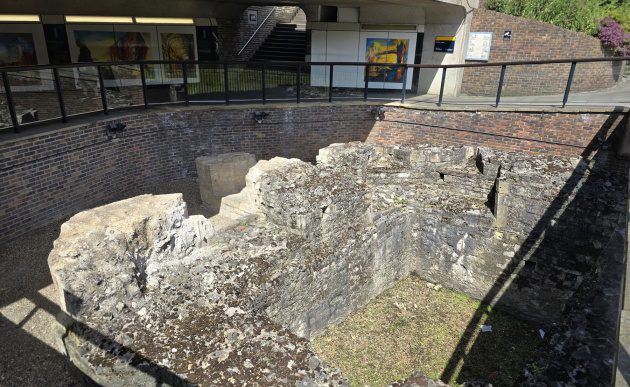Aldersgate
Aldersgate was a London gate on the north-west of the city that originated in the Roman period.

The principal roads in and out of Roman London were through Aldgate, Bishopsgate, Newgate and Ludgate, as well as through the fort at Cripplegate. Alders Gate, in the north-west of the city, was of a later Roman construction, some time after the building of the wall. It may have been a replacement for a postern gate. It stood across a road that under various names runs north from St. Paul’s Cathedral through Clerkenwell, Islington, and then eventually to the north of England and Scotland, known as the Great North Road. It was located a short distance from St. Paul’s at the point where the road changed its name from St. Martin Le Grand to Aldersgate Street. The meeting point of the two moved slightly north in the 20th century to a junction that was formed with the newly-created street of London Wall. The gate was therefore on what is now St. Martin Le Grand.
There are various theories regarding the gate’s naming. Tudor historian John Stowe believed it to be because during his time in the 16th century it was an ancient structure and therefore the ‘older’ gate. More probably it is named after an Anglo-Saxon landowner and in the late Saxon period was known as Ealdredesgate, meaning Ealdred’s gate. The name gradually evolved to Aldersgate.
Throughout the medieval period the Collegiate Church and Precinct of St. Martin Le Grand was located on the inside of the gate, to the east of the street now known by that name. In 1068 King William granted land to the monastic church, which had been built by two brothers at their own expense and dedicated to St. Martin of Tours. During the reign of Edward I the ringing of the bell of St. Martin’s announced the start of the city’s nighttime curfew when all the gates were to be locked. The institution was dissolved by Henry VIII and demolished. Between 1829 and 1911 the General Post Office stood on the site.
From the 12th century the church of St. Botolph stood immediately north and outside of the gate, where it remains today. Three of the former city gates are adjacent to churches dedicated to the 7th century Saxon Abott Botolph, patron saint of travellers. (A fourth at Billingsgate, the former fish market on the Thames, was destroyed in the Great Fire and never rebuilt). In medieval times, when a journey outside the city could be a dangerous undertaking, it was common for travellers to pray for their safe passage at one of the St. Botolph churches as they arrived or departed. The ancient St. Botolph-without-Aldersgate on Aldersgate Street was rebuilt in the early 17th century. Unlike most other City churches it was only damaged in the Great Fire but not destroyed. It was later rebuilt and completed in 1791.
Over the medieval Aldersgate were rooms for the use of the gate-keeper. During the 14th century it was the home of the City of London’s sword-bearer, and later the common crier. It was described as being in very poor condition in the early 16th century but it would take until the following century before it was rebuilt.
Stowe wrote at the end of the 16th century that the gate:
“hath at sundry times been increased with buildings; namely on the south, or inner side, a great frame of timber hath been added and set up, containing divers large rooms and lodgings; also on the east side is the addition of one great building of timber, with one large floor, paved with stone or tile, and a well therein kerbed with stone, of a great depth, and rising into the said room, two stories high from the ground; which well is the only peculiar note belonging to that gate, for I have not seen the like in all this city to be raised so high.”
Stowe notes that the gate had been the residence of John Day, the printer and publisher who died in 1584. In his lifetime Day had published several notable books, including John Foxe’s ‘Book of Martyrs’. Stowe also wrote of the Castle Inn, which stood beside the gate on its east side. To the south of the gate was the Boulogne Mouth coaching inn, later renamed the Bull and Mouth.
The medieval gate was finally demolished in 1618 and rebuilt by the City of London to the design of Gerard Christmas, using funds left by the late merchant tailor William Parker. It had a central arch for traffic and posterns either side for pedestrians. On the outer face was an equestrian statue of King James I, who had ridden through it when arriving in London in 1603 from his native Scotland to take the English Crown. On the inner side was another of James on his throne. On the two side of the structure were Biblical quotes. That on the eastern side was from the prophet Jeremiah: “Then shall enter into the gates of this city kings and princes, sitting upon the throne of David, riding in chariots and on horses, they and their princes, the men of Judah, and the inhabitants of Jerusalem; and this city shall remain for ever.”
Aldersgate was damaged in the Great Fire and repaired but demolished in 1761 and the materials sold for £91.
<Back to The City Wall and Gates of London
Sources include:
- Alan Brooke ‘Gates of the City of London’
- Walter Thornbury ‘Old & New London’
- John Stow ‘A Survey of London’ (1598)
- Stephen Millar ‘London’s City Churches’
- Dominic Perring ‘Roman London’


